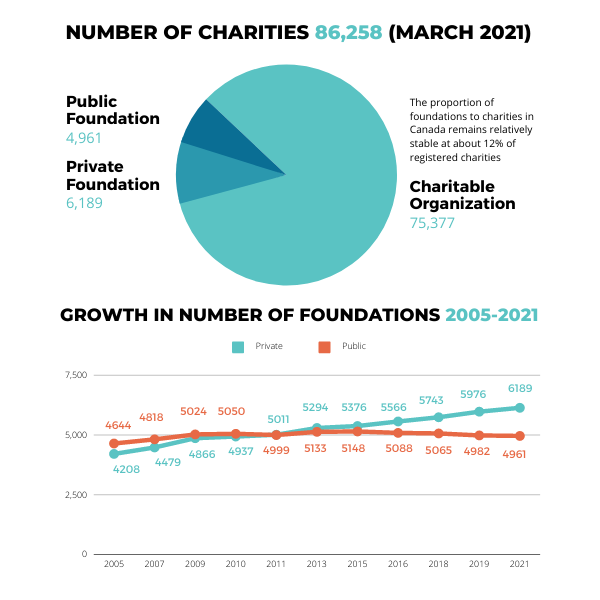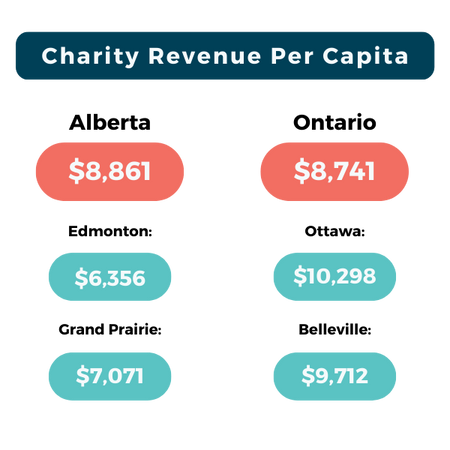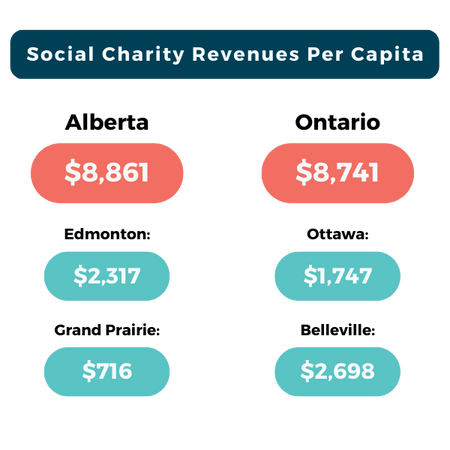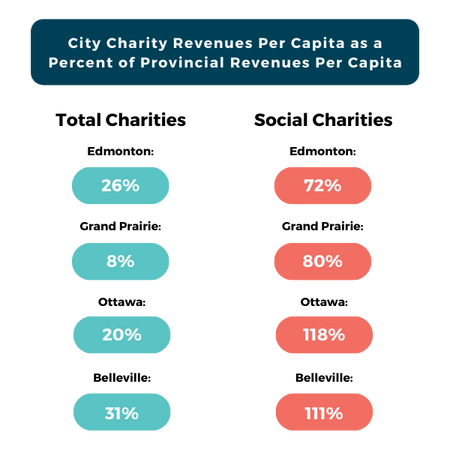Across Canada every year, billions of dollars flow into the social safety net via charitable organizations and private foundations. Whether it’s government funding (tax dollars) or direct charitable giving from individuals, this significant investment into supports of all kinds makes up a colossal proportion of our country’s social infrastructure.
Through HelpSeeker’s extensive work examining funding flows, we know the amount of charitable funding ranges drastically from province to province, and city to city, but why? Is there a grand design to charitable funding in Canada, and can an intentional framework be deciphered? And what can be done about obvious funding misalignments?
Charities vs Foundations
First, we need to examine the differences between charitable organizations and private foundations. We’re unpacking big numbers because these organizations include big spenders like: hospitals, post-secondary, schools – all the things that keep society healthy and productive. While many of us don’t know it, from a legal and tax perspective, our health authorities, our universities, and even our school boards have charity status. In this way, they operate very differently from just having the government running services in-house – these entities have relationships with the state to deliver services to the population. That’s also why you’ll still get a tax receipt if you make donations to these entities.
Next we can look at public and private foundations which flow funds through, rather than deliver direct services, who are also charities – and we have a growing number of them (which may be a good or bad thing in the long run according to some researchers).

Examining Funding Flows
So why is HelpSeeker, a social tech company, examining funding flows for charities? Part of our work involves what we call Financial Flows Audits. The term is a simple way to describe an important and complex concept, and it’s related to our efforts to make sense of the labyrinth social safety net in a way that’s easy to understand, and then convert this into a platform to help people navigate social services. We sought to answer the question of what the impact (outcomes) was from the various services and their funding streams.
Prior to the work HelpSeeker has been doing, funders and decision makers across the country would have to dig for the answers to the questions: what social services and supports are available in my community, what populations and groups do they serve, who’s funding them and what impact do they have on the wellbeing and safety of my community? And most critically, what’s the right service supply mix for my community? Thanks to the HelpSeeker Community Success Hub, this information is now readily available in an accessible, easy-to-understand digital dashboard.
Over the past few years, we’ve had the chance to test and refine Financial Flows Audits all over the country – Edmonton, Moncton, Kelowna, Ottawa, Abbotsford, Nanaimo, to name a few. Unsurprisingly, there is a tremendous difference from region to region – but certain themes are consistent: fragmentation, lack of coordination, and lack of transparency for end-users.
The big picture has also become clearer – the truth is that the social safety net is massive, convoluted, and worth an exorbitant amount of money. We mapped about $380B annually – and no, that’s not including the health and education systems – mainly social services, poverty supports, mental health and addictions.
The full scope of this figure is not yet known – the data are not as transparent when we contract social services to non-profits or for-profit entities versus charities – making it hard to get financial details. These entities can either be a charity or a non-profit – but cannot be both.
Charities registered with the CRA are able to issue tax receipts and are obligated to file annual financial information. Conversely, non-profits are operated exclusively for social welfare, civic improvement, and recreation, and don’t have spending or CRA tax requirements, making it harder for us to follow their money. All this to say, there is more ‘digging’ to be done and the more we follow the money, the more insightful the analysis.
Identifying Misaligned Funding Challenges
When it comes to foundations, I am always fascinated when we follow how money comes in from donors and government into a foundation and how much of it ends up in frontline service provider charities.
When we look at various provinces, the picture gets even more complex because no one does it the same. For instance, Alberta’s per capita charity revenue sits at $8.8k, which is similar to Ontario at $8.7K, but vastly different from Prince Edward Island at $2.6K, or even more drastically, Nunavut at $2.3K.

Even within a province, cities and regions vary widely. Let’s take a look at Alberta and Ontario again – picking on cities we have done work in more specifically: Belleville and Ottawa in Ontario, and Edmonton and Grande Prairie in Alberta. Look at how divergent the capitals and smaller centers are, but even comparing Ontario and Alberta, how drastically different these numbers are. More interestingly, what’s happening to the provincial averages when we drill into cities of varying sizes? What causes this difference? And how are these differences impacting service delivery in the charitable sector?
Clearly, major differences within the same provincial jurisdictions matter – they entwine with the considerable approaches to defining government and charity roles – who does what, and how? This raises some questions as to the cause and impacts of the variance in geographies – what are our rationales for the decisions behind these numbers?

Now let’s look at what the charity revenue is dedicated to – of course, we have the usual big-ticket items: health and education. But what we are always interested in is the social sector – those charities that are doing the heavy lifting on homelessness and affordable housing, mental health and addictions, poverty reduction – how does this play into the picture?
Not surprisingly, we see variance from province to province: for instance, Alberta’s per capita social charity revenue sits at $1.1k, which is notably lower than Ontario’s at $1.7K, and still higher (though less drastically than the total charity spend) from New Brunswick at $0.7K, and Nunavut at $0.4K.
Let’s follow our two case study provinces again with the social lens in Alberta and Ontario – two very similar per capita overall provincial numbers, but a pretty big difference compared to what we track into the cities. Of course, this is meant to be illustrative of variance – and the need to understand the math and why the results are so divergent.

For Ontario, the two cities are at about a fifth (Ottawa) to a third (Belleville) of the total provincial per capita for charitable spend; Alberta’s capital Edmonton is similar to Belleville at about a third and notably higher than Grande Prairie, AB. Drilling deeper into social charities – both Belleville and Ottawa are notably higher than the provincial average, compared to Alberta cities where we see them at about ⅓-⅕ less than the average.

Fixing Misaligned Funding: Intentionality
The purpose of this article is to showcase the value of this work using just one of the 10-15 datasets we use in a Financial Flows Audit. It is one of the greatest assets we have in the Financial Flows Audit work, and it comes courtesy of the Canada Revenue Agency. Thanks to the legislation requiring registered charities to maintain their tax-free status, all financial information has to be disclosed – what comes in and what goes out. This is just one of the 10-15 datasets we use in a Financial Flows Audit, and obviously it’s a very good one to be familiar with and is often our starting point in a new community. It gives a clear picture of the charitable financial flows into the social safety net.
Interestingly, although charities are essential vehicles in delivering Canada’s social safety net to those in need of support with a diverse range of needs – housing, food, counselling, addiction treatment, to name a few – we understand relatively little about charities as a whole in this process. This is in part because some assumed they just know ‘how it works’ or because they were too overwhelmed by complexity when they tried to dig into it.
What we’re drawing attention to here, more specifically, is the tremendous diversity we see in how charities manifest, even from province to province. We are often called upon to provide insights on the future of the social safety net and how we might increase impact, reduce inefficiencies or inequities – but are often stumped at how we might even begin without some of this basic knowledge about funding flows.
Without transparency, it’s next to impossible to talk about how we might “fix,” “optimize,” etc. In many ways, this data is nothing new – it’s called taxation, something we’re all obligated to participate in, just the same as organizations with registered charity numbers. The data is not a secret – it’s out there as open data and Open Government. The challenge is understanding it in context and deriving real-world solutions from the findings (creating real-world impacts in your community).
There is significant work to be done still, and both our team and our clients are asking a number of questions that we work to understand and solve, and unpack and solve again as the social safety net shifts.
- Who are these charities, are they delivering similar services? How many are delivering frontline service vs administrative/coordinating functions?
- Is there a right amount of funding? Is there an optimal service per capita or service mix?
- Can we do it better, cheaper, kinder? Are we shortchanging some areas that need something more?
- Are we being equitable and advancing reconciliation through how, where and who we fund?
- What are the outcomes? Is it better to fund more to get more outcomes?
- Is there a max/min funding change before effects are felt either way – positive and negative?
- What’s the right prevention-intervention mix? How is that different between regions?
- If we knew the optimal service mix and funding allocations to get the desired population outcome (say Medicine Hat ending homelessness – but replicable and scalable), could we plan more proactively and strategically?
- Could we make this something anyone could understand and use in diverse decision-making situations?
- What would this mean for how we made investment or policy decisions? What would be disrupted in a positive or negative way – and what would remain steadfast despite disruption, in a positive or negative way?
A major outstanding challenge remains: even if we can answer all of these questions, would decision makers be open to changing how they approach funding and policy or service decisions in practice or is this a futile pipedream? Obviously, we don’t think this is futile – it’s hard work for anyone who plays even the smallest role in key decisions that impact funding allocation in the social safety net. Our work at HelpSeeker involves obsessing about these questions and packaging them up so they make sense to more people.
We have developed supply mapping and Financial Flows Audits that leverage proprietary data from Canada’s largest supply map. These solutions allow us to understand the misalignment of the social response of a community. We can understand supply and demand of the social safety net and examine funding across all levels, enabling communities to optimize the existing supports and financial assets. This data allows us to right-size the social safety net and develop integrated funding strategies to determine where and how much funding is most needed.
Intentionality – being mindful of our roles in these decisions, balancing being critical yet creative thinkers, strategic and decisive – will be the future of smart funding. The technology, data insights, and tools we use, the new questions we ask, and the ones we now have answers to will enable us to be intentional.
Our actions and decisions stack into what ultimately results in someone getting the right help at the right time through the alignment of our support systems. Just imagine, if you were not only provided a crystal clear picture of where charity funding is coming from, and what types of service providers are receiving funding, but also knew precisely what population types were being served – and not – could you not instigate immediate change with that information?
We need to ask ourselves: how can we transform our decision making to align funding to meet the wellbeing and safety needs of our communities?



